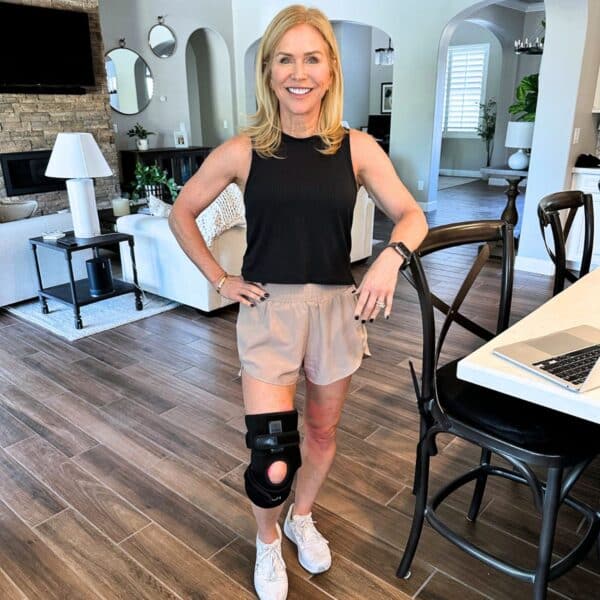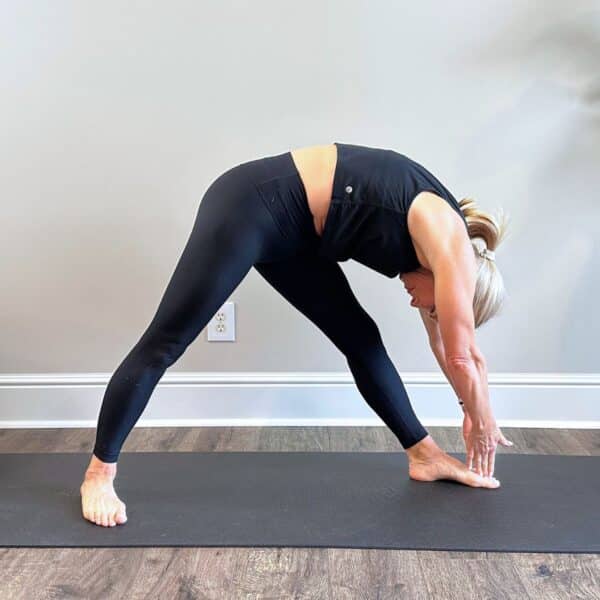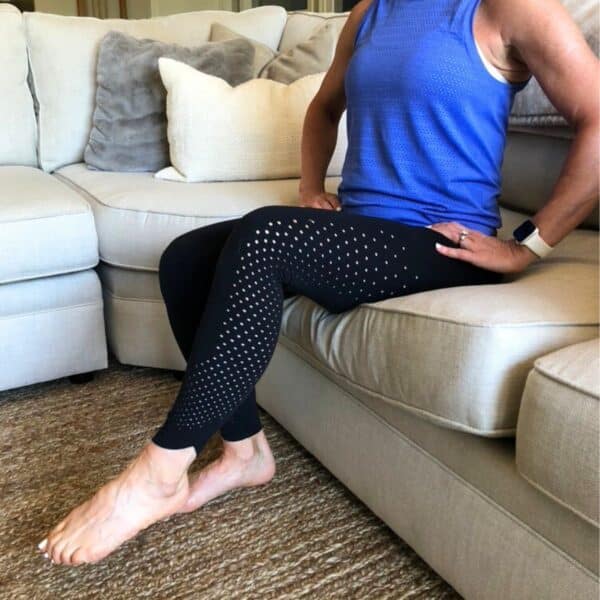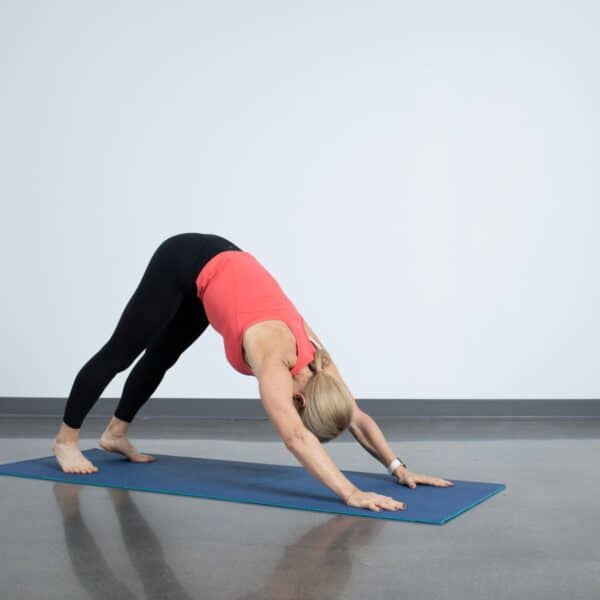This post contains affiliate links. Please see our disclosure policy.
Fitness has no age limit. Contrary to what you may have been told, you can absolutely get into the best shape of your life after 50.
In fact, the perks of a regular exercise routine become more noticeable as you grow older. Getting into shape builds confidence and muscle, helping you feel and look younger than other people your age.
Plus, you’ll see plenty of other anti-aging benefits from exercise, like better balance and coordination, improved mood, and greater bone density.
Are you ready to get into shape after 50? Great, let’s dive in! We’ll look at some of the benefits of exercise in greater detail, and then uncover the best strategies to transform your body.
The Benefits of Exercise After 50
A handful of important benefits of exercising after 50 include:
Keeps Your Heart Healthy
changes that happen to your heart as you age can increase your risk of high blood pressure, heart disease, and stroke. Aerobic exercises like walking and jogging are especially good for keeping your heart strong and healthy, according to the American Heart Association (AHA).
Lowers Body Fat
All types of physical activity can help you lose fat and maintain a healthy weight, which is key for lowering your risk of age- and lifestyle-related health conditions like heart disease and type 2 diabetes, according to the CDC.
Builds Muscle and Bone
We all start losing muscle mass around the age of 30, and bone mass around 40. If you don’t do anything to prevent that loss, you’ll have a hard time keeping up with your favorite sports and everyday activities as you age.
Strength training can help you stay strong, active, and independent for the long-haul.
How to Get In Shape After 50
Getting fit after 50 doesn’t have to be complicated. Here are several strategies you can use to simplify the process — and make it more enjoyable, too.
Set goals and track your progress
Your first step: Identify a goal or two. Having clear goals will remind you why you’re exercising at all, and motivate you to stick with it even on days when you’d rather sit on the couch.
You’ll be most successful if you make the goal(s) both specific and realistic. So, instead of a vague goal like, “Get in shape,” or an unrealistic goal like, “Lose 20 pounds in one month,” come up with something clear and manageable.
For example: Lose 20 pounds in five months.
Once you have a goal that’s specific and doable, break it down into smaller steps so you can track your progress more easily. So, if your goal is to lose 20 pounds in five months, you should aim to lose roughly four pounds per month, or one pound per week.
That’s right on par with healthy weight loss recommendations from the CDC. If you haven’t lost four pounds by the end of the month, it could be a sign that something you’re doing isn’t working.
Or, maybe you need to tweak your goal.
Revisit your goal if your motivation dips. Ask yourself: “Why do I want to lose 20 pounds in five months?”
If you can’t come up with any good reasons (ex. “I want to get off this prescription for high blood pressure,” or “I want to be able to keep up with my kids”), it might be time to rethink your goal.
Pick cardio and strength training activities you enjoy
There are plenty of trendy workouts you could do to reach your goals, but honestly, the best workout is the one you’ll actually do. You’re more likely to get your workouts done if you enjoy them, so think about what activities you like: Were you a ballet dancer as a kid? Do you head for the hotel pool when you go on vacation?
Pick activities you like, but be sure to incorporate both cardio and strength training into your routine.
If you hate exercising solo, recruit your friends to join you. Or, find an online fitness community where you can swap workouts and advice, and take online workout classes with a live trainer.
No one says you have to do this alone!
Staying active outside your workout can help you get in shape, too, so find reasons to get on your feet during the day. Take your dog for a walk, hit the park with your kids or your best friend, and do stretches when you watch TV.
Make tweaks to your diet
All that hard work and sweat won’t pay off if you keep going back to old eating habits. So many women 50 and over feel defeated when exercise doesn’t bring results, but many are also eating tons of sugar and processed foods.
Well, you may have been able to get away with poor eating habits when you were younger, but your hormones are changing (thanks, menopause!), making it even more important to pay attention to how you eat.
Inflammation in particular becomes a bigger issue once you reach menopause. As estrogen levels drop during menopause, inflammation goes up, increasing your risk for Alzheimer’s, obesity, and other chronic health conditions.
Eating a Mediterranean diet — a diet full of whole grains, fruits, vegetables, and legumes, as well as foods rich in monounsaturated fats like olive oil, nuts, and fish — is probably your best bet for fighting inflammation and making your exercise count.
Start by making small changes: Find healthier swaps for your favorite indulgences, choose smarter bedtime snacks, cut back on alcohol, try to eat red meat only a few times per month (limit your servings to three ounces), and incorporate fruits and veggies into most meals.
Avoid foods with chemicals, preservatives, and food colorings whenever possible.
For more healthy eating tips, check out our beginner’s guide to the Mediterranean diet.
Schedule your workouts
You wouldn’t skip a doctor’s appointment, would you? (Well, hopefully not.) Treat your workouts the same way by plugging them into your calendar.
Try to schedule your workouts for times when you have the most energy. In other words, don’t plan on exercising first thing in the morning if you’re not a morning person. That said, many of us have other commitments that take priority, so you may have to settle for a less-than-ideal time.
Experiment to find the time block that works best for you and your schedule.
Start slow and build up gradually
Motivation is usually high at the beginning of any goal, but don’t let your enthusiasm get the best of you. Many people try to take on too much when they start a new fitness routine, only to end up overly sore and burned out after just a few weeks.
Set yourself up for long-term success by easing into exercise, especially if that exercise is new to you. This may mean starting with only two or three workouts per week, and lightening the intensity or length of those workouts until you’re ready to add more.
Try not to beat yourself up about taking things slow, either. If you stick with it, you’ll be doing tougher moves and more hardcore routines in no time!
Listen to your body and incorporate rest
It’s normal to feel a little sore for a day or two after a workout, but anything longer or more intense than that is a problem. Take a few days off from exercise and do some light activity (e.g., walking, swimming, yoga) instead.
Then, when you work out again, lighten up a bit so you don’t repeat that soreness.
Also, let up if you feel any sharp pains during exercise. You could be doing something your body’s not ready for, or using improper exercise form. If the pain keeps coming back during exercise, or it turns into chronic, longer-lasting pain, get help from a personal trainer and/or physical therapist.
Get help early on; don’t try to push through and hope the pain goes away on its own.
Talk to your doctor before you start a new exercise routine
If you haven’t exercised in a while, get cleared by your doctor before starting your fitness program. This is especially important if you have any chronic conditions like heart disease or diabetes, and/or if you take prescription medications.
Also, be sure to check with your doctor if you have any problems during or after exercise, like heart palpitations, dizziness, and/or nausea or vomiting. It’s best to be safe when exercising!
Ready to get started? Try out this 20-Minute Bodyweight HIIT workout great for women over 50.
30-Minute Total Body Strength Circuit Workout:
Follow along with the strength training video below to see the breakdown of each strength exercise. This workout will include 11 total strength movements and breaks the workout into lower body, upper body, and core circuits.
To keep the workout low impact, there will be no jumping involved throughout this workout. See the video of each movement broken down and the written protocol below.
- Perform each exercise for 12 – 15 reps. Taking no breaks in between movements.
- Once you complete each of the 3 circuits, take a 1 minute rest. Repeat x 3 sets total!
See the written workout below!
Circuit 1 – Lower Body Focus:
- Basic Squats
- Dumbbell Deadlift
- Single Leg Glute Bridge
- Forward (or Reverse Lunge) with Bicep Curl
Circuit 2 – Upper Body Focus:
- Overhead Shoulder Press
- Reverse Grip Row
- Tricep Kickback
- Modified Push-Ups
Circuit 3 – Core Focus:
- Full-Body Roll-Up
- Plank Hold (Hold for anywhere between 30 seconds to 1 minute; or hold it as long as you can!)
- Bird Dog
Challenge yourself to come back to this specific strength workout every month and track your progress!
Grab a set of dumbbells and do this 30-minute total body strength circuit!







danke danke danke Chris
I have been following an Australian woman on exercises after 50 that are low impact. it is great to try yours as i’m a pretty active 53 year old who looks 30!! Obviously my insides know my age 🙁
I’m definitely in for a HIIT workout!!
I ve been doing this this whole week so far that’s 3 days. I’m sweating like crazy like dripping when I’m done with 3 sets. I hope to see results I’m gonna keep going with it. 49 and overweight in menapause and want my body back. Hoping to look for good my 50th bday.
Thank you fir this will check out other info on this site too, but started here. Emily – oregon